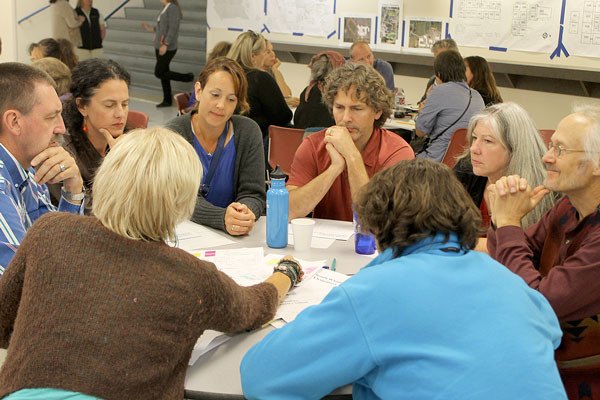Programs seem to be a more prized possession in the South Whidbey School District than its buildings following a community planning meeting Wednesday night in the commons of South Whidbey High School.
Around 50 people attended the meeting and their input spoke strongly for consolidation of more of the district’s school facilities. The goal for the meeting was to discuss ways to reduce the district’s footprint while maintaining or enhancing its programs. Declining enrollment over the last decade has led to fewer monies in the district’s general fund and the district and school board are looking to trim spending where it can, but not without first receiving feedback on the community’s values and interests.
Attendees, split into seven groups, were asked to create various scenarios for how the district could save money during a hour-long discussion. Of the 19 scenarios presented, over half revolved around consolidation.
Possible scenarios included moving grades K-5 from the elementary school to Langley Middle School, housing 6-12 in South Whidbey High School, and K-7 at the primary school.
Other ideas were year-round school, a merger with the Coupeville School District, an all-island merger, do nothing, food service overhaul and four-day weeks.
Consolidation of school facilities is familiar territory for the district, district administrators said.
The district has rented out buildings such as the Bayview School and part of Langley Middle School, moved the 9-12 South Whidbey Academy program into an unoccupied wing of the high school and consolidated its district office into the transportation building. The primary school is also split in usage by the academy’s K-8 program, as well as Skagit Valley College. K-5 is at the elementary school, formerly known as the intermediate school.
“It’s feasible,” Superintendent Jo Moccia said. “The question is not whether we can, it’s what should we do?”
“The reality is that we already have [done it],” Assistant Superintendent Dan Poolman added. “I think about the primary and intermediate [schools].
It was the second time school leaders and the community have met to discuss the future of the district. Over 100 people attended the first meeting in May. Three more meetings are planned — Oct. 19, Dec. 7 and Jan. 18, 2017 — before a February meeting where the board will meet for a workshop to discuss facilities. The board will make any changes official at a meeting in March.
While the first meeting in May included a long presentation on the district’s budget and enrollment decline as well as questions from the community, Wednesday night was primarily about generating ideas.
In the first few minutes of the meeting, Moccia asked the crowd to think like a board member so they could see the bigger picture in mind rather than their own point of view. The meeting was a success, she said.
“We came up with some good ideas and the whole point is for us is to see what the community is thinking about and they’d like their district to do,” Moccia said.
Kathy Borson of Langley said she liked the fact that the district is being transparent and is involving the community in the process, though she added the district was not as involving of the community when it moved the academy’s 9-12 program.
“My takeaway is that it seems like they are open to possibilities,” Borson said.
Borson said the district is facilities rich but student poor, and that one or the other has to give. Deciding how to consolidate will be the challenge, she said.
“I think that part of the problem is coming up with what the costs will be in order to do that,” Borson said.
Her husband, Nick Borson, said by prolonging the process with meetings scheduled over the span of months, every community member will have a chance to have their voice be heard. He said that rumors around the community has led to misconceptions. One of the rumors claimed that all the decisions had already been made by the district or board. He felt that by attending the meetings, people have a chance to hear what is being discussed for themselves.
Freeland resident Patrick Martin felt the draw of South Whidbey Academy for off-island residents is being overlooked. Martin said he and a few other families moved to the island for the academy’s program, and that the academy’s enrollment has been increasing.
He also said that consolidating buildings is a step in the right direction toward saving money.
“I’m very hopeful that people will begin to look at the benefits of consolidating the buildings so that we would have more available money for programs,” Martin said. “If there’s a will there’s a way. It’s about communicating that point that programs are more important than buildings.”



